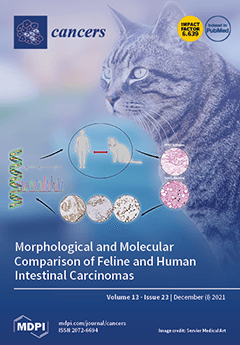Background: Lung cancer is the leading cause of cancer-related deaths. Early diagnosis may improve the prognosis.
Methods: Using quantitative methylation-specific real-time PCR (qMSP-PCR), we assessed the methylation status of two genes (in two subsequent regions according to locations in their promoter sequences)
[...] Read more.
Background: Lung cancer is the leading cause of cancer-related deaths. Early diagnosis may improve the prognosis.
Methods: Using quantitative methylation-specific real-time PCR (qMSP-PCR), we assessed the methylation status of two genes (in two subsequent regions according to locations in their promoter sequences) related to carcinogenesis,
DICER and
DROSHA, in 101 plasma samples (obtained prior to the treatment) of lung cancer patients and 45 healthy volunteers.
Results: The relative level of methylation of
DROSHA was significantly lower (
p = 0.012 for first and
p < 0.00001 for the second region) and
DICER significantly higher (
p = 0.029 for the first region) in cancer patients. The relative level of methylation of
DROSHA was significantly (
p = 0.037) higher in patients with early-stage NSCLC (IA-IIIA) and could discriminate them from healthy people with a sensitivity of 71% and specificity of 76% (AUC = 0.696, 95% CI: 0.545–0.847,
p = 0.011) for the first region and with a sensitivity of 60% and specificity of 85% (AUC = 0.795, 95% CI: 0.689–0.901,
p < 0.0001) for the second region. Methylation analysis of the first region of the
DICER enabled the distinction of NSCLC patients from healthy individuals with a sensitivity of 96% and specificity of 60% (AUC = 0.651, 95% CI: 0.517–0.785,
p = 0.027). The limitations of the study include its small sample size, preliminary nature, being an observational type of study, and the lack of functional experiments allowing for the explanation of the biologic backgrounds of the observed associations.
Conclusion: The obtained results indicate that the assessment of
DICER and
DROSHA methylation status can potentially be used as a biomarker for the early detection of lung cancer.
Full article






